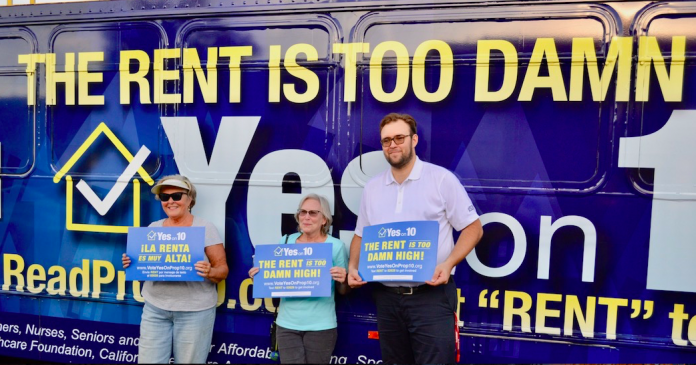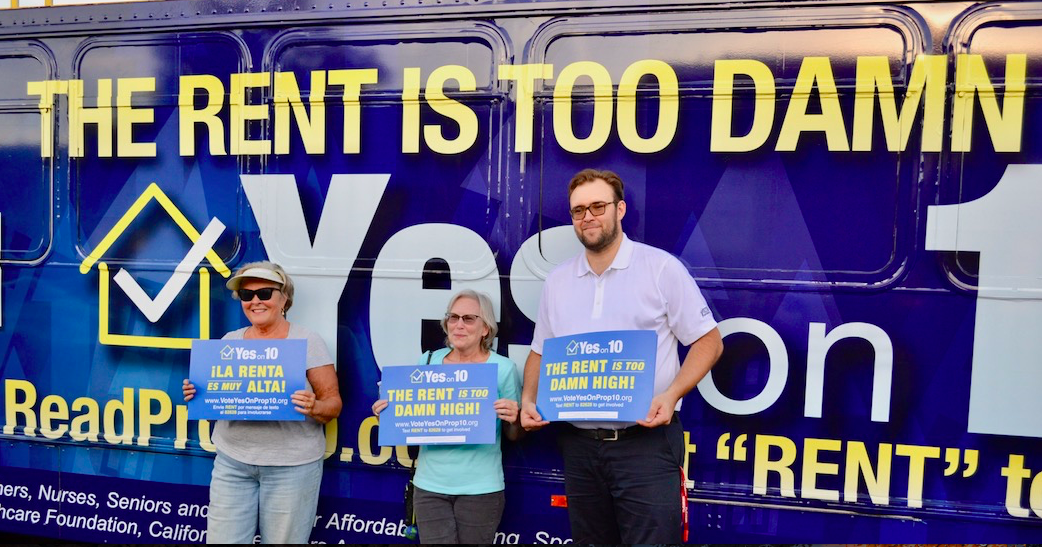
The landlord lobby – and it’s one of the most powerful interests in the state of California – is spending more than $40 million to convince voters not to support Prop. 10 – a measure that would allow (but not require) cities to impose effective rent controls.

It’s gotten considerable support – the LA Times, the largest newspaper in the state, came out in favor. The San Francisco Chronicle, on the other hand, opposes Prop. 10– and makes the exact argument that the real-estate industry is pushing:
But more rent control — and more local government control — will probably further suppress the supply of housing and deepen the crisis for the state. More housing is the way out of the housing shortage. Proposition 10 is not.
That’s been a real-estate industry argument for decades: Rent control will stop (private sector) developers from building housing, and what we need is more (private-sector) housing.
But a recent study out of the University of Southern California challenges that argument.
The USC study, sponsored by the California Community Foundation, suggests that rent control tends to keep rents lower even in uncontrolled buildings, helps preserve housing and community stability – and has little discernable impact on the construction of new housing.
The study’s authors are not economists. The lead author, Manuel Pastor, is a sociologist. The two other authors, Vanessa Carter and Maya Abood, are urban planners.
But unlike the Stanford economists who put out a complex study on the economics of rent control, complete with equations that almost nobody can understand, the USC report looks at the existing literature on rent control.
There’s quite a bit of it, and much has been cited badly or used in inaccurate arguments.
The USC researchers are all about moderate rent regulations, including rent controls that exempt vacant apartments. But they suggest that different solutions are appropriate for different cities. And the most important argument they make, in the context of the Prop. 10 campaign, is that rent control does not discourage new housing:
On balance, new housing supply is more influenced by cyclicality in the local economy and other local conditions than rent restrictions (Arnott 1995; Gilderbloom 1981).
Gilderbloom and Ye (2007) used regression analysis of 76 New Jersey cities with rent stabilization and found that there was little to no statistically significant effect of moderate rent control on new construction after controlling for population, racial demographics, population change, income, the percentage of units that were renter occupied, vacancy rates, and unit age. Similarly, Sims (2007), in an analysis of Boston, Cambridge, and Brookline, MA, found that while building construction permits did rise after the repeal of rent stabilization in 1995, multifamily building permits actually reached their height in the mid to late 1980s—during rent stabilization.
This should be obvious to anyone who understands the economics and dynamics of housing development in the United States today.
Development isn’t driven by a need for housing; the major factor is the availability of investment capital. And since capital is now almost entirely global, the money goes where the highest return is.
Right now, that’s luxury condos in cities like San Francisco, New York, and Vancouver.
Rent control has no impact on those investment decisions, since they units that are getting build are, for the most part, going to be sold immediately and not rented out.
When the capital goes for rental units, it’s a pretty simple calculus. The investor wants to see a return – right away. In case you didn’t notice, banks and real-estate trusts no longer think long-term.
So if a rental housing project has a projected cost of $100 million, and the investor needs a 10 percent return, then the rents – net of all costs, including maintenance and taxes – have to total $10 million a year. That’s how rents are set. And rent control has nothing to do with that. What happens in five or ten years, when rents might remain the same, isn’t relevant – the investment is returning what the investors demanded. The ability to get immediate return is far more important to real-estate investors than what may happen ten years from now.
There are investors who buy existing housing with the goal of getting rid of rent-controlled tenants and raising rents, but that’s not new housing construction.
So the idea that Prop. 10 will discourage new housing in California has little basis in fact.
And of course, since a significant amount of the (private-sector) housing in California isn’t affordable to anyone who works here, and is being purchased by investors who don’t even occupy those units, it’s hard to argue that market-rate housing is going to help the crisis anyway.
I’m waiting to see how the news media that are so eager to report on any study that attacks the premise of Prop. 10 will report on one that says it might actually help the housing crisis in California.

